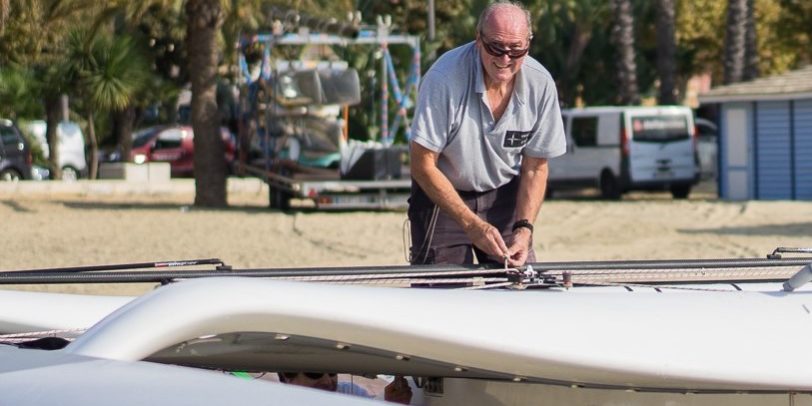At 67, Dave Thomas is a happy owner, which shows that the Diam 24 od is suitable for all types of sailors. Between regattas in compensated time and monotype-boats races, this British native, settled in Antibes, carries out races 25 days per year.
What is your regatier history ?
I have been navigating on multihulls for almost 30 years. I learned how to sail in Southampton in Great Britain. I started when I was 21 but it was on a classic dinghy. It’s perfect for a learner. Then I went for the Hobie Cat 16, not to compete but just for fun. Afterwards I bought a F25C. I was the only one with this type of multihull in France and all in all, there are only 40 of them in the world. It’s a carbon made trimaran, very fast. I have participated with it in races for 20 years in France. I won three times the French multihulls Championship
How did you come to the Diam 24 od ?
My trimaran was getting old and needed a lot of maintenance, although I did everything by myself. I wanted to change and try a newTrimaran type. I looked at a variety of models. There were 23 feet boats, Seacat 26, Seacats30. I saw that the Diam 24 was a very good package to replace my carbon fibre boat.
My previous boat was twice as heavy, that is 950 kgs with a very huge sail. The Main Sail was bigger. The spinnaker too. It’s the same compromise. You need large sails but you also need to sail safely. I felt that the Diam, with its twin rudders, with its capacity to roll-in the fore-sails, was the best option. Moreover, it offered excellent value for money. The boat is great. It’s really enjoyable. It’s easy to sail, it’s a very secure boat.
I chose the Diam24od for its flexibility. The Diam 24 unique conception platform enabled me to optimise the boat for the different rating systems.
What is your programme ?
Thanks to the trailer I can travel from Toulon to Hyères. I am focused on the monotype regattas in this region. This summer, I am planning to go to Great Britain with the boat to participate in the « Round the Island » race and in the Cowes Week as well.
I participated once in the Cowes Week with my F25C. I know the conditions and the tricky tides there and the type of racing course given. The possibility to place the boat on the trailer, to cross the Channel, and to participate in a monotype race is a great opportunity. On the return journey, I will perhaps sign-in the boat for the Trophée des Multicoques, at la Trinité sur Mer. It’s a multi-challenges combination. I mostly navigate here in Antibes, Cannes and against multihulls. I thus obtained a rating for the boat.
It represents how many racing days ?
I try to race about 25 days per year. It really depends on the availability of my crew. The boat is very practical to be carried from one place to another, on the trailer. The only challenge that I meet is to find places to launch the boat. It might be with the help of a crane or launch-areas. It’s not very easy in this region. There are fewer multihulls than in the West as it is very difficult to find places to store boats. I store mine outside Antibes and I leave the trailer with the boat, which is quite practical.
What about your crew ?
I have some regular crew members, for example Karine. She joigned me 2 years ago. She had never sailed before. I taught her sailing and everything about multihulls, and now she does very well. I mostly navigated with French nationals all along.
I also have two other outstanding crew members, Renaud and Edward with whom I have been sailing for more than 20 years. The Diam is easy in hand but difficult to navigate fast during competitions. It depends on specific tuning. It depends on the crew members, on the weight on board, and it takes time to learn how to sail fast with it. We are progressing now, because we have been sailing on this boat for over 2 years. For safety purposes we often need three persons who know how to steer.
Do you have a specific configuration for the Mediterranean sailing area ?
The boat is really conceived for strong winds, I would say, from my experience between 10 and 15 knots. This is when we can push it to its maximum capacity. Most of the races disputed in this area are against 7 or 10 knots winds. So the boats need bigger sails. I am in contact with ADH team because I am interested in what they did for the rigging systems used on the Bol d’Or event. For handicap races I have likewise modified my boat so as to benefit from larger sails. It’s a customised boat. Thanks to Vianney’s supports, ADH engineers and the advices from Randy Smith (twice silver medal winner at the Olympic games, ndr), I was able to optimised the sails configuration for the different rating systems (M2K and MOCRA, ndr).
Is it problematic to have a fleet made of professionals and amateurs ?
The Tour de France and the World Tour are enticing for most of the professional crews. That’s not really a problem to have amateurs and professionals together. We know that we can’t make it first but we can still struggle to come close up to the runners up and we learn a lot when racing next to professionals. The fact of having more boats and more regattas is a virtuous circle. The more regattas there are the more there are boats.







